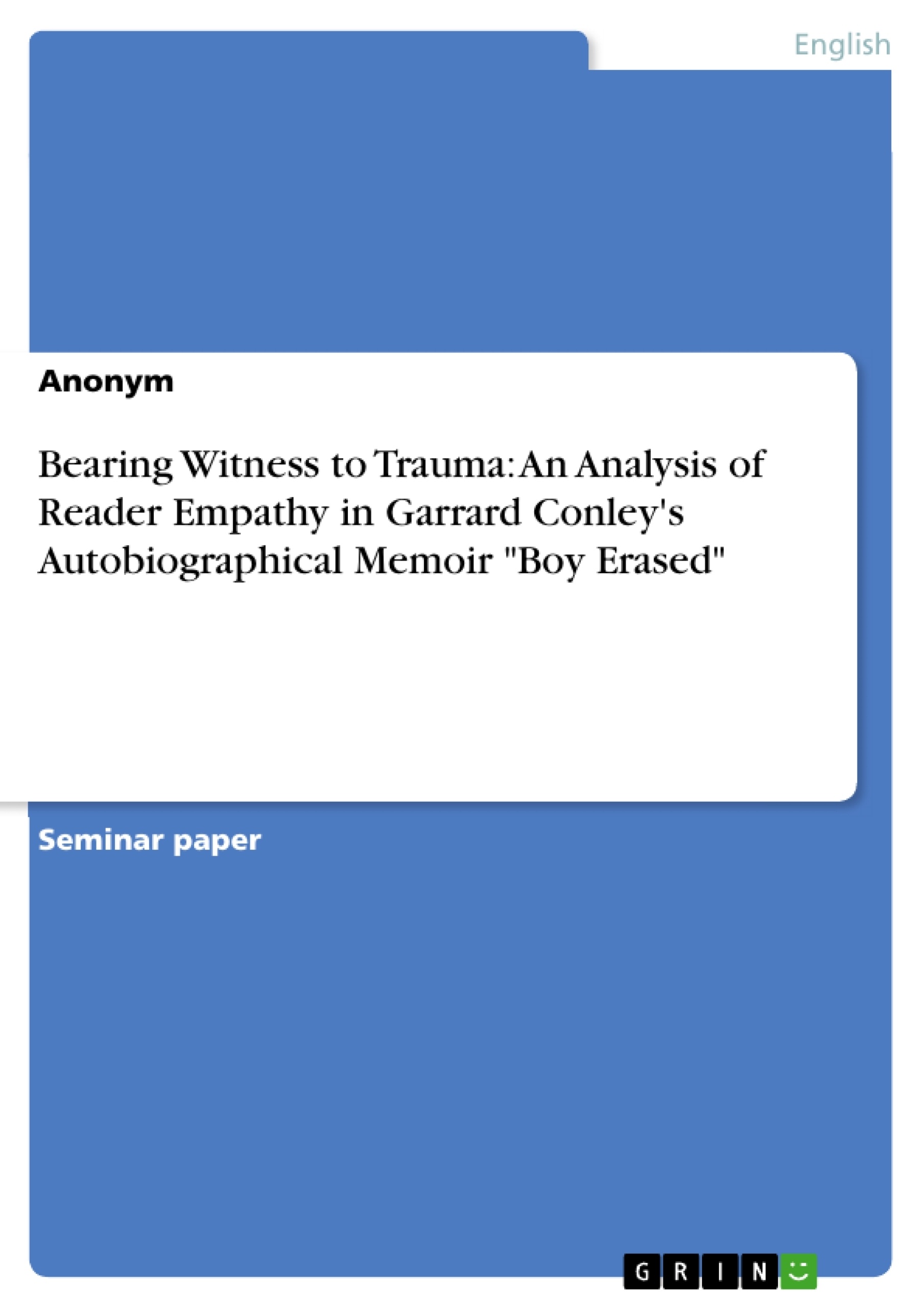Boy Erased can be read as a trauma narrative with a special focus on the trauma narrative's function of creating reader empathy described by Laurie Vickroy. Therefore, this paper argues that Boy Erased offers the narrative strategies of the first-person point of view, interior monologues, foregrounding, and providing insight views into another character's thoughts and feelings to fulfill the trauma narrative function of creating reader empathy.
To prove this thesis, the paper's content is structured like the following. Firstly, the text gives a theoretical background on ex-gay conversion therapy, its harmful effects as well as its current relevance to the United States. Moreover, the paper defines reader empathy in trauma literature as described by Vickroy .Here, the chapter lays out the most important concepts for the analysis of reader empathy in the primary text. After that, the relevance of reader empathy specifically in Boy Erased will be pointed out. The next chapter covers an elaborate analysis of how Conley engages reader empathy throughout the memoir. Finally, the paper's central findings will be summarized in a conclusion with an outlook on further research.
Inhaltsverzeichnis (Table of Contents)
- Introduction
- Background and Theory Chapter
- Ex-Gay Conversion Therapy in the United States
- Laurie Vickroy on Trauma Literature and Reader Empathy
- Relevance of Reader Empathy in Boy Erased
- Defining Empathy
- Analysis of Reader Empathy in Boy Erased
- Conclusion
Zielsetzung und Themenschwerpunkte (Objectives and Key Themes)
This paper examines the memoir Boy Erased by Garrard Conley, analyzing how the narrative strategies employed contribute to the creation of reader empathy. The paper draws on the theoretical framework of trauma literature, particularly Laurie Vickroy's work on the function of empathy in trauma narratives. Through an in-depth analysis of Boy Erased, the paper aims to demonstrate how the memoir effectively engages readers emotionally and invites them to connect with the experiences of the protagonist.
- Ex-gay conversion therapy and its historical and societal context
- The impact of conversion therapy on individuals, particularly on mental health and trauma
- The role of trauma literature in creating reader empathy and fostering understanding
- The narrative strategies employed in Boy Erased to evoke empathy in readers
- The importance of exploring the complexities of trauma and its effects on individuals and communities
Zusammenfassung der Kapitel (Chapter Summaries)
The introduction provides a historical overview of ex-gay conversion therapy, highlighting its origins and enduring relevance in the United States. It introduces the concept of trauma narratives and their role in fostering reader empathy. The chapter also briefly outlines the paper's central argument and the structure of the analysis. The background and theory chapter delves deeper into the history and effects of ex-gay conversion therapy. It explores the motivations behind seeking such therapy, as well as the potential psychological harm it can inflict on individuals. This section also introduces Laurie Vickroy's perspective on trauma literature and its ability to create reader empathy, laying the foundation for the subsequent analysis of Boy Erased.
Schlüsselwörter (Keywords)
This paper explores the intersection of trauma narratives, reader empathy, and ex-gay conversion therapy. Key themes include the psychological effects of conversion efforts, the function of empathy in trauma literature, and the narrative strategies employed in Boy Erased. The paper focuses on the memoir's use of first-person perspective, interior monologues, and foregrounding techniques to connect with readers on an emotional level and invite them to consider the experiences of the protagonist.
- Arbeit zitieren
- Anonym (Autor:in), 2020, Bearing Witness to Trauma: An Analysis of Reader Empathy in Garrard Conley's Autobiographical Memoir "Boy Erased", München, GRIN Verlag, https://www.hausarbeiten.de/document/1474082


